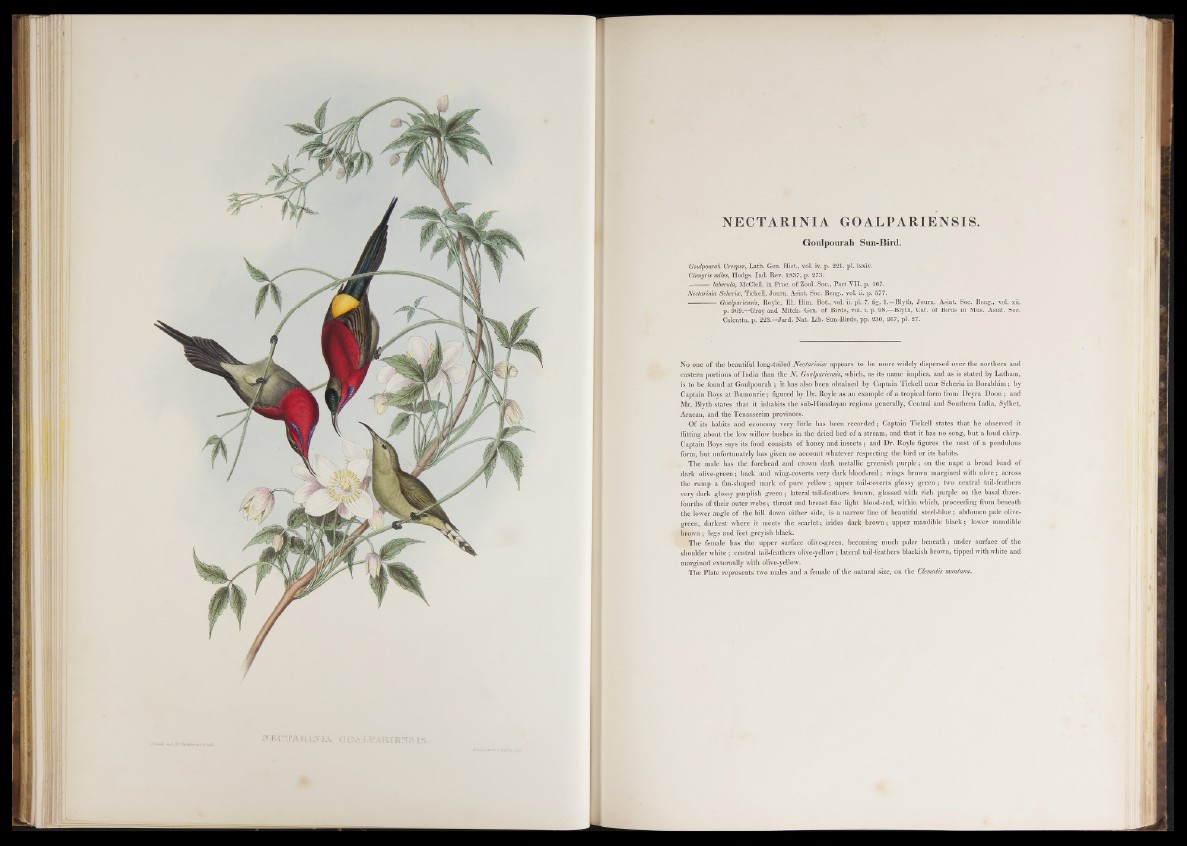
N E C T A R I N I A G O A L P A R I E N S I S .
Goulpourah Sun-Bird.
G outpour ah Creeper, Lath. Gen. Hist., vol. iv. p. 221. pi. hndv.
Cimyris miles, Hodgs. Ind. Rev. 1837, p. 273.
— labecula, McClell. in Proc. of Zool. Soc., Part VII. p. 167.
Nectarinia Seherice, Tickell, Journ. Asiat. Soc. Beng., vol. ii. p. 577.
:---- Goalpariensis, Royle, 111. Him. Bot., vol. ii. pi. 7. fig. 1.—Blyth, Joum. Asiat. Soc. Beng., vol. xii.
p. 969.—Gray and Mitch. Gen. of Birds, vol. i. p. 98.—Blyth, Cat. of Birds in Mus. Asiat. Soc.
Calcutta, p. 223.—Jard. Nat. Lib. Sun-Birds, pp. 230, 267, pi. 27.
No one of the beautiful long-tailed Nectarinia appears to be more widely dispersed over the northern and
eastern portions o f India than the N . Goalpariensis, which, as its name implies, and as is stated by Latham,
is to be found a t Goulpourah ; it has also been obtained by Captain Tickell near Seheria in Borabhim; by
Captain Boys at Bumourie; figured by Dr. Royle as an example o f a tropical form from Deyra Doon ; and
Mr. Blyth states that it inhabits the sub-Himalayan regions generally/ Central and Southern India, Sylhet,
Aracan, and the Tenasserim provinces.
Of its habits and economy very little has been recorded; Captain Tickell states th at he observed it
flitting about the low willow bushes in the dried bed of a stream, and that it has no song, but a loud chirp.
Captain Boys says its food consists of honey and insects; and Dr. Royle figures the nest o f a pendulous
form, but unfortunately has given no account whatever respecting the bird or its habits.
The male has the forehead and crown dark metallic greenish purple; on the nape a broad band of
dark olive-green; back and wing-coverts very dark blood-red; wings brown margined with olive; across
the rump a fan-shaped mark o f pure yellow; upper tail-coverts glossy g re e n ; two central tail-feathers
very dark glossy purplish g ree n ; lateral tail-feathers brown, glossed with rich purple on the basal tbree-
fourths of their outer webs; throat and breast fine light blood-red, within which, proceeding from beneath
the lower angle of the bill down either side, is a narrow line o f beautiful steel-blue; abdomen pale olive-
green, darkest where it meets the scarlet; irides dark brown; upper mandible black; lower mandible
brown ; legs and feet greyish black.
The female has the upper surface olive-green, becoming much paler b eneath; under surface of the
shoulder white ; central tail-feathers olive-yellow; lateral tail-feathers blackish brown, tipped with white and
margined externally with olive-yellow.
The Plate represents two males and a female of the natural size, on the Clematis montana.